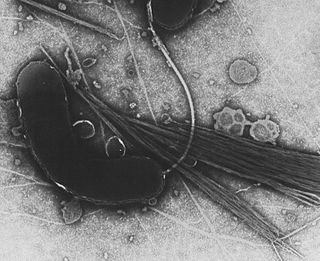Related Research Articles

The Rhizobiales are an order of Gram-negative Alphaproteobacteria.
The Aurantimonadaceae are a small family of marine bacteria. Six species are known. Aurantimonas coralicida causes a white plague in corals. Fulvimarina pelagi was isolated from seawater, and takes the form of nonmotile rods.

The Vibrionaceae are a family of Proteobacteria given their own order, Vibrionales. Inhabitants of fresh or salt water, several species are pathogenic, including the type species Vibrio cholerae, which is the agent responsible for cholera. Most bioluminescent bacteria belong to this family, and are typically found as symbionts of deep-sea animals.

The Burkholderiaceae are a family of bacteria included in the order Burkholderiales. It includes some pathogenic species, such as Burkholderia mallei (glanders) and Burkholderia pseudomallei (melioidosis).

Halomonadaceae is a family of halophilic Proteobacteria.
Pediococcus is a genus of gram-positive lactic acid bacteria, placed within the family of Lactobacillaceae. They usually occur in pairs or tetrads, and divide along two planes of symmetry, as do the other lactic acid cocci genera Aerococcus and Tetragenococcus. They are purely homofermentative. Pediococcus dextrinicus has recently been reassigned to the genus Lactobacillus.
The indole test is a biochemical test performed on bacterial species to determine the ability of the organism to convert tryptophan into indole. This division is performed by a chain of a number of different intracellular enzymes, a system generally referred to as "tryptophanase."
Pelomonas saccharophila is a Gram-negative soil bacterium. It was originally named Pseudomonas saccharophila in 1940, but was reclassified in 2005 to the newly created genus, Pelomonas. The original strain was isolated from mud.
Cronobacter is a genus of Gram-negative, facultatively anaerobic, oxidase-negative, catalase-positive, rod-shaped bacteria of the family Enterobacteriaceae. They are generally motile, reduce nitrate, use citrate, hydrolyze esculin and arginine, and are positive for L-ornithine decarboxylation. Acid is produced from D-glucose, D-sucrose, D-raffinose, D-melibiose, D-cellobiose, D-mannitol, D-mannose, L-rhamnose, L-arabinose, D-trehalose, galacturonate and D-maltose. Cronobacter spp. are also generally positive for acetoin production and negative for the methyl red test, indicating 2,3-butanediol rather than mixed acid fermentation. The type species of the genus Cronobacter is Cronobacter sakazakii comb. nov.

Actinobacillus is a genus of Gram-negative, nonmotile and non-spore-forming, oval to rod-shaped bacteria occurring as parasites or pathogens in mammals, birds, and reptiles. It is a member of the family Pasteurellaceae. The bacteria are facultatively anaerobic or aerobic, capable of fermenting carbohydrates, and of reducing nitrates. The genomic DNA contains between 40 and 47 mol % guanine plus cytosine.

Arcanobacterium is a genus of bacteria. They are gram-positive, non–acid fast, nonmotile, facultatively anaerobic, and non–endospore forming. They are widely distributed in nature in the microbiota of animals and are mostly innocuous. Some can cause disease in humans and other animals. As with various species of a microbiota, they usually are not pathogenic but can occasionally opportunistically capitalize on atypical access to tissues or weakened host defenses.
Thermoanaerobacter is a genus in the phylum Firmicutes (Bacteria). Members of this genus are thermophilic and anaerobic, several of them were previously described as Clostridium species and members of the now obsolete genera Acetogenium and Thermobacteroides
Thermoanaerobacter pseudethanolicus is a thermophilic, strictly anaerobic, spore-forming bacteria that was first found at Yellowstone National Park in the United States. Because of its ability to efficiently ferment sugars, it is thought to be of potential use in producing industrial alcohol.
Aureimonas ureilytica is a bacterium from the genus of Aurantimonas. Aurantimonas ureilytica was reclassified to Aureimonas ureilytica.

Lactobacillus delbrueckii is a species of bacteria in the family Lactobacillaceae. It is part of the microbiota of the lower reproductive tract of women.
Prosthecomicrobium is a genus of aerobic bacteria which was isolated from freshwater samples.
Coprobacillus is a Gram-positive, obligate anaerobic and non-motile genus from the family of Erysipelotrichidae, with one known species.
Kandleria vitulina is a bacterium from the genus Kandleria isolated from calf rumen.
Olsenella profusa is a bacterium from the genus of Olsenella which has been isolated from subgingival plaque in the United States.
Giesbergeria voronezhensis is a Gram-negative, spiral-shaped and motile bacterium from the genus of Giesbergeria which has been isolated from activated sludge from Voronezh in Russia.
References
- 1 2 3 4 Parte, A.C. "Kandleria". LPSN .
- ↑ "Kandleria". www.uniprot.org.